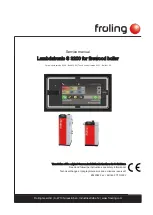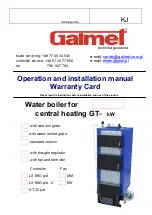
Finned copper tube gas boilers & water heaters – Boiler Manual
31
MAINTENANCE
Disconnect electrical power and close the manual gas
shut off valve before performing maintenance or severe
personal injury may result!
Servicing, inspection and adjustment must be done
by a trained technician in accordance with all appli-
cable local and national codes. Improper servicing or
adjustment can damage the boiler/water heater!
The boiler/water heater must be cleaned and inspected at least once
a year and before each heating season. Make sure that the burner
and ignition components are free from dust, soot, dirt, corrosion
or other deposits that would impair the boiler/water heater’s
performance. Refer to Figure 25 for component identification.
Improper burner servicing can result in premature
burner failure voiding the warranty!
Burner Removal
1. Close the manual shutoff valves in the gas supply line and turn
off electrical power to the boiler/water heater.
2. Remove the jacket top panel.
3. Disconnect the wires to the fan and remove the four bolts that
secure the fan to the transition piece.
4. Remove wires from the spark rods and remove the UV sense
from the transition piece.
5. Disconnect the compression nut at the back of the transition
piece to remove pilot gas tubing.
6. Remove the four nuts holding the transition piece to the heat
exchanger.
7. Lift and remove the transition piece and burner together from
the boiler/water heater, taking care not to damage the spark
rods and or their alignment.
8. Disconnect the compression nut from the inside of the transition
piece.
9. Remove the transition piece, taking care not to damage the
spark rods and or their alignment.
Heat Exchanger Inspection
1. Close the manual shutoff valves in the gas supply lines and turn
off electrical power to the boiler/water heater.
2. Remove burner following the instructions in the
Burner
Removal
section.
3. Remove the front jacket panel and combustion chamber door.
4. Inspect the inside and outside of the heat exchanger for signs
of damage, sooting or corrosion.
5. The outside surfaces of the copper tubes should be free of any
soot deposits. A slight black smudge is normal with some types
of gases. Black soot indicates poor combustion. Green deposits
indicate condensation due to low return water temperatures. In
either case the heat exchanger must be cleaned thoroughly and
the problem resolved before the boiler/water heater is returned
to service.
6. If there are no signs of damage, sooting or corrosion, reassemble
the unit following the previous steps in reverse order.
7. A badly corroded or damaged heat exchanger must be replaced,
see the
Heat Exchanger Repair & Replacement
section.
Heat Exchanger Cleaning
1. Close the shut off valves in the inlet and outlet piping. On heat-
ing systems close the system fill valve and relieve the system
pressure from the boiler by carefully lifting the relief valve or
opening the drain valve.
2. Disconnect the boiler/water heater from the system piping.
3. Remove the eight bolts on the rear pipe enclosure panel.
4. Remove the front jacket panel and combustion chamber door.
5. Slide the heat exchanger out of the unit.
6. Remove the “V” baffle straps and “V” baffles.
7. Thoroughly clean the heat exchanger with water from
a high-pressure hose. Use a soft bristle brush if necessary.
8. Replace the cleaned heat exchanger and other components in
the reverse order of their removal.
Heat Exchanger Repair & Replacement
1. A leaking or otherwise damaged tube(s) can be replaced as
outlined in steps 2 through 8.
2. Remove the heat exchanger from the boiler/water heater as
outlined in the
Heat Exchanger Cleaning
section.
3. Remove the pipe plugs from the inlet/outlet and return headers
opposite from the ends of the tube(s) being replaced.
4. Carefully cut the damaged tube(s) in half, taking care not to
damage the adjacent tubes and remove.
5. Install and swage/expand in place the new tube(s).
6. Replace the pipe plugs using a suitable thread sealant on each
one.
7. Sagging or distorted heat exchanger tubes are an indication of
low water flow through the system. A damaged heat exchanger
must be replaced and the condition that caused the damage
resolved before the boiler/water heater is returned to service.
8. Replace the heat exchanger and other components in the reverse
order of their removal.
9. The recommended torque value for the heat exchanger plugs
is approximately 45 ft. lbs, not to exceed 50 ft. lbs.
Air Intake & Vent System
Thoroughly inspect the air intake and vent systems for any
signs of blockage, corrosion or leakage. Immediately replace any
unsound vent system piping. Inspect the air filter and wash with
warm water and soap if dirty.














































